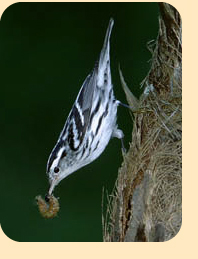 |
|||
|
|
|||
|
 What Species: Overwintering Neotropical migrants, including Bewick's Wren (Thryomanes bewickii), Orange-crowned Warbler (Vermivora celata), Yellow-rumped Warbler (Dendroica coronata), Common Yellowthroat (Geothlypis trichas), Spotted Towhee (Papilo maculatus), Lincoln's Sparrow (Melospiza lincolnii),White-crowned Sparrow (Zonotrichia leucophrys). What Species: Overwintering Neotropical migrants, including Bewick's Wren (Thryomanes bewickii), Orange-crowned Warbler (Vermivora celata), Yellow-rumped Warbler (Dendroica coronata), Common Yellowthroat (Geothlypis trichas), Spotted Towhee (Papilo maculatus), Lincoln's Sparrow (Melospiza lincolnii),White-crowned Sparrow (Zonotrichia leucophrys).
Where: Yucatãn Peninsula, Quintana Roo; Ayuquila River, Jalisco; Colorado River Delta, Sonora; Baja California; Sacramento Valley, California; San Joaquin Valley, California. Who: Dr. Steven Latta (National Aviary) and locally-based partners at each site. When: 2004 – present Why: Populations of many once common species of songbirds are declining. At the same time, the official listing of species as threatened or endangered is becoming politically problematic and financially difficult. Thus, new habitat conservation efforts must increasingly focus on the needs of multiple species that are still common enough to be able to respond to acquisition, restoration, and land management changes. Currently in California and elsewhere, billions of dollars are being invested in habitat enhancement activities with little knowledge of the biological needs of affected species and no evaluation of their efficacy. It is imperative that managers answer the question, “Do our projects work to improve wildlife values for multiple species?” If projects do not engage broad interests and lack scientific basis, well-intentioned conservationists may not only waste money but may also contribute to ecosystem decline. Riparian habitat is one of the most important types of habitat for birds. In California, riparian areas have been identified as the single most important habitat for the protection and conservation of songbirds and support a disproportionately high number of migrants. However, it is estimated that at least 98 percent of riparian habitat in the Central Valley has been lost in the past century through human-induced changes, including urban development, water diversions, and conversion to agriculture. In response to these changes, public and private organizations are investing millions of dollars in riparian conservation including restoration, enhancement, and acquisition, with thousands of acres slated for restoration along major California and western rivers and their tributaries. Measuring multiple bird species response to these conservation efforts will help guide management and provide a cost-effective evaluation of restoration activities. Current Goals: We are relating bird use, overwinter site persistence, and survivorship to restoration design, silvicultural practices, water flow regimes, and other restoration activities. Because in this study we are able to work simultaneously in well-conserved riparian plots and restoration plots, and because these sites have been previously assessed as breeding habitat for Neotropical migrants by PRBO and partners, we are in a unique position to: (1) describe the wintering ecology of Neotropical migrants in riparian habitat in both the temperate and tropical zones; (2) evaluate the value of riparian restoration efforts for migrants during the nonbreeding period; and (3) test whether restoration conditions favorable to breeding birds translates to conditions favorable to wintering birds. Next Steps: Field work for this four-year study was completed in 2008. Page 2 
|



